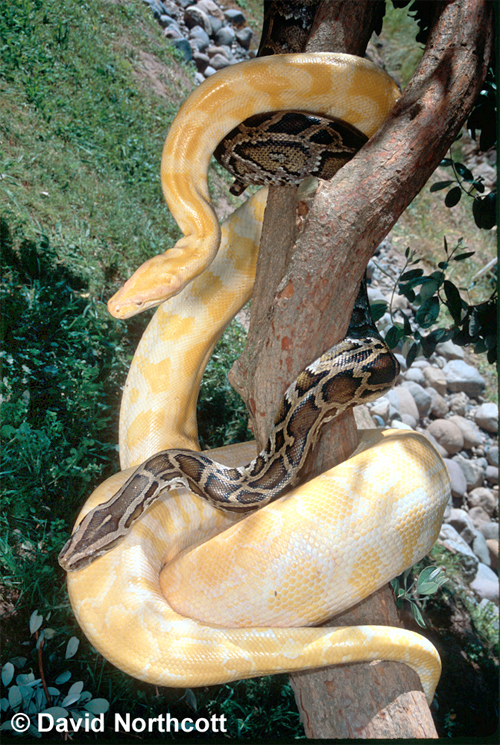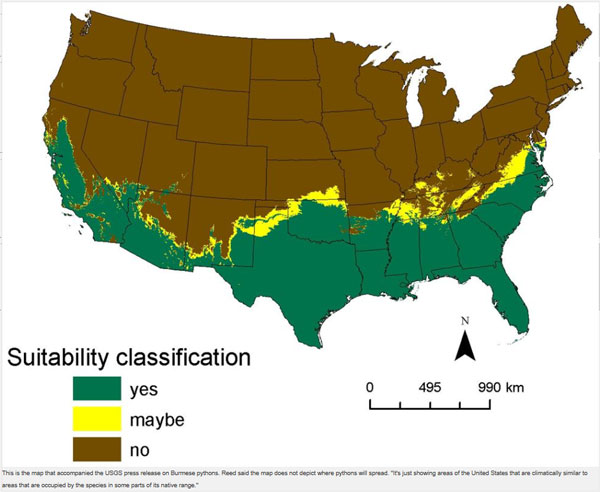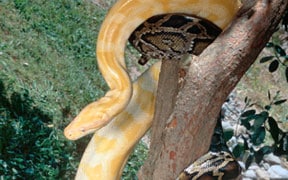Experts in the reptile industry have expressed concern over a U.S. Geological Survey (USGS) study stating Burmese pythons could inhabit roughly one
Experts in the reptile industry have expressed concern over a U.S. Geological Survey (USGS) study stating Burmese pythons could inhabit roughly one-third of the United States.
The study comes at a critical time for the reptilekeeping industry. On Jan. 31, the U.S. Fish and Wildlife Service (USFWS) issued a Notice of Inquiry for information regarding constrictors of the genera Boa, Python and Eunectes.
This was interpreted by many in the industry as a USFWS proposal that would classify these snakes as injurious wildlife, which could then lead to a ban on their importation and interstate transportation.

Photo by David Northcott
Burmese pythons
The Burmese python is a subspecies of the Indian python, which is present in the Everglades National Park and poses a risk to several species listed as threatened or endangered under the U.S. Endangered Species Act, the study states. The existence of Indian pythons in the Everglades is partially the result of release of unwanted pets, Bill Brandt, of The Gourmet Rodent, said on a website discussion addressing the issue.“This is the reason the whole herp community needs to participate in do-not-release projects such as Habitattitude,” said Brandt, who is also a member of PIJAC’s board of directors.
The USGS study compared some aspects of the climate in the United States to that of the natural range of the Burmese python, while assuming that the Burmese python and the Indian python are identical in their requirements, Bob Clark, an Oklahoma snake breeder, said in an interview with ReptileChannel.com.
“The Indian python may live in some areas where it may experience cooler temperatures,” he said. “The study makes a leap here, first assuming that the two different snakes have the same tolerance for cold and, second, that the ability to tolerate cold would make all habitats of similar temperature suitable habitat.”
Snake breeder Dave Barker agreed. “The article is based on very poor data, used a very poor analysis of the data and came to the wrong conclusions. I think the paper is biased, self-serving and dishonest.”

This is the map that accompanied the USGS press release on Burmese pythons. Reed said the map does not depict where pythons will spread. "It's just showing areas of the United States that are climatically similar to areas that are occupied by the species in some parts of its native range."
Barker also said he felt the article sensationalized a non-existent problem. “In doing so, I believe it wrongly caused financial damage to tens of thousands of businesses, including real estate brokerages, property owners, and townships and cities in the American south by declaring that the south was about to be invaded by an ‘alien python.’ ”
Robert Reed, co-author of the USGS study, disagreed, saying the study merely presents the native range climate of non-native pythons and projects it to the United States.
“We haven’t looked at habitat suitability, prey availability or other ecological factors. We have no idea whether they can survive,” he said.
Reed added that most media reports, which carried headlines such as “Giant Snakes to Slither into State” and “Pythons could squeeze lower third of USA,” misunderstood the study.
If it’s possible for Burmese pythons to colonize areas in the southern United States, Clark poses the question of why they haven’t colonized areas adjacent to their natural range. “I’d also ask how Burmese pythons respond to cold temperatures. Do they hibernate? What kind of place would be necessary for them to hibernate successfully? Do these conditions exist in the area the study shows on the map as definitely suitable for colonization?”
Clark also expressed concern about the timing of the study’s release. “I was concerned, but not alarmed, when public comment was requested on the proposed python/boa listing, until the USGS study came out a couple of weeks later,” he said, adding, however, that when questioned about the timing of the study on a discussion at a website, a USFWS representative said it was a coincidence.
Click here to read the full interview with snake breeder Dave Barker.
Click here to read Barker’s articles that appeared in the Bulletin of the Chicago Herpetological Society.



